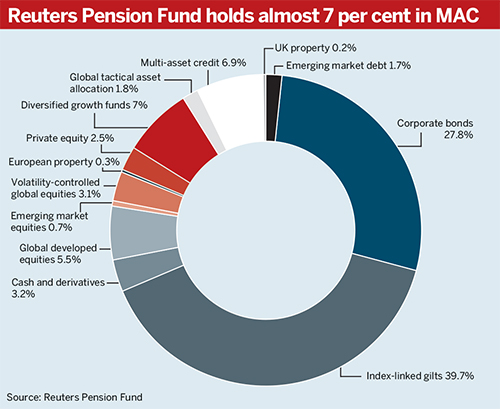The Reuters Pension Fund has invested in a second multi-asset credit fund and dropped a loans fund, as the lure of high risk-adjusted returns continues to draw investors to MAC products.
Asset managers have launched an array of MAC products over the past five or six years in reaction to investor demand. Product launches peaked in 2013, but there continues to be a strong pipeline, a 2016 paper by consultancy bfinance found.
MAC strategies offer access to sub-investment grade
The £2.4bn Reuters defined benefit scheme had already invested £75m in MAC in 2015, via a dynamic bond fund managed by TwentyFour Asset Management.
It’s the flexibility and diversity the MAC can offer. The manager can access a range of credit rather than one specific variety
Mark Ashworth, Law Debenture
Late last year, it added about £80m by investing in a CQS fund that “was specifically selected as a complement to TwentyFour (in terms of regional exposure and sector focus)”, the scheme told members in July this year.
It pulled out of the Babson European loan fund to finance the move. “The rationale behind this decision was that multi-asset credit was more suitable for RPF’s long-term strategic objectives and would be a more efficient way of gaining exposure to sub-investment grade credit markets,” the scheme said.
It also put in place a dynamic risk management framework about a year ago, and hit a funding trigger in January that led to further derisking. At the end of March 2017, the estimated funding on a going concern basis had reached 103.4 per cent.

The trustees of the 7,400-member scheme did not comment on the investment changes, but said a major contributor to the scheme hitting its funding target had been the level of hedging in the portfolio. In March, the scheme held nearly 40 per cent of its assets in index-linked gilts and about 3 per cent in cash and derivatives.
Loans have lost their lustre
Mark Ashworth, chair of Law Debenture Pension Trustees, said he was “generally in favour of MAC [products]”, noting that he has had positive experiences in terms of risk-adjusted returns.
“It’s the flexibility and diversity the MAC can offer. The manager can access a range of credit rather than one specific variety,” he said.
Those who are still invested in loan funds should ask themselves if the potential return justifies the risk, said Ashworth. “Schemes need to be careful. I wouldn’t want to say that there is a general cause for concern, but there is a cause for care.”
David Will, a senior investment consultant at JLT Employee Benefits, also warned that “loans have done quite well in recent times, and there has been a lot of repricing and refinancing activity”, meaning investors should be selective.
“It’s important for anyone investing in loans to know that there are some borrowers out there that are taking advantage of what is a borrower’s market,” he said.
Strathclyde earmarks £750m for MAC and private debt
The Strathclyde Pension Fund made large allocations to both private debt and multi-asset credit last year as it looks to take advantage of the growth in non-bank intermediaries.
Will expects more schemes to allocate assets to MAC strategies. For smaller schemes in particular, “MAC is a very sensible way for them to get access to credit risk premia”.
He added that combining liability-driven investment – which manages interest rate and inflation risk – with MAC was “quite popular”.
Chris Redmond, global head of credit and diversifying strategies at consultancy Willis Towers Watson, highlighted that valuations in the syndicated loans space are “reasonably stretched”, saying investors are pulling out of this area.
“They are moving into strategies that have got a broader opportunity set, and you are assuming that the manager has the skills and greater tools to navigate in a market where the beta looks less attractive. That’s the MAC concept,” he explained.
Consultants highlight market opportunities
Redmond said schemes trying to move away from market betas have various options. They could increase active management, including through MAC products, switch capital into derisking assets, or move into less liquid assets like private debt.
The view that private markets are attractive for pension funds was echoed by John Walbaum, head of investment consultancy at Hymans Robertson.
“At the moment, given what’s happened to spreads [in] the public market… we certainly like the opportunities available in the private market,” he said.














